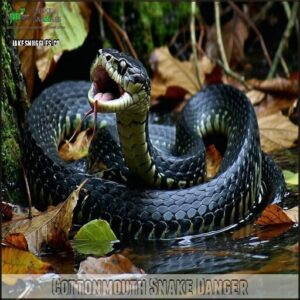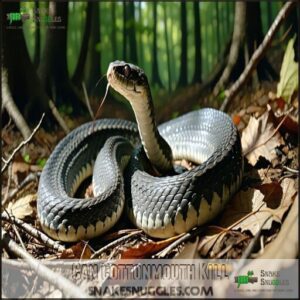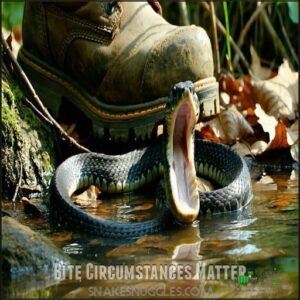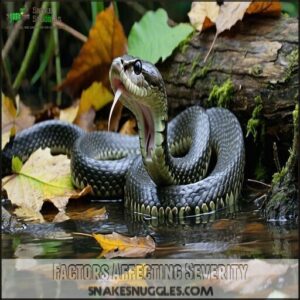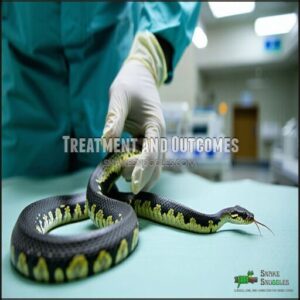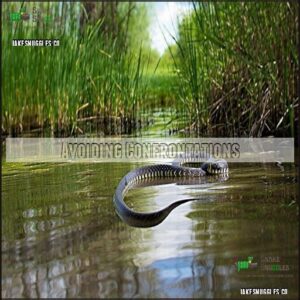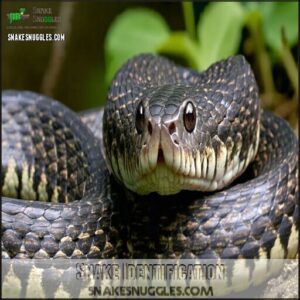This site is supported by our readers. We may earn a commission, at no cost to you, if you purchase through links.
 A cottonmouth’s bite can kill you, but it’s more of a worst-case scenario than a likely outcome.
A cottonmouth’s bite can kill you, but it’s more of a worst-case scenario than a likely outcome.
These snakes, also called water moccasins, have venom that breaks down blood cells and tissue, causing severe pain, swelling, and potential complications if untreated.
Deaths are rare, especially with quick medical care, but the bite’s severity depends on factors like the venom dose, where you’re bitten, and your body’s response.
Cottonmouths usually strike when threatened, so giving them space can save you a lot of trouble.
Curious how to identify or avoid these snakes? Stick around for practical tips on staying safe, and learn how to handle a potential worst-case scenario with the right medical care.
Table Of Contents
- Key Takeaways
- Cottonmouth Snake Danger
- Can Cottonmouth Kill
- Cottonmouth Venom Potency
- Bite Circumstances Matter
- Factors Affecting Severity
- Treatment and Outcomes
- Prevention and Safety
- Frequently Asked Questions (FAQs)
- What is the Average Size of a Cottonmouth?
- Are Cottonmouths Active During the Day or Night?
- Are There Any Other Symptoms of a Cottonmouth Bite?
- What is the Best Way to Identify a Cottonmouth?
- Are There Any Natural Predators of the Cottonmouth?
- Can you survive a cottonmouth bite?
- What are the chances of dying from a cottonmouth bite?
- How fatal are cottonmouth snakes?
- Will a water moccasin bite kill a human?
- What is the average size of a cottonmouth?
- Conclusion
Key Takeaways
- Cottonmouth bites are highly unlikely to be fatal if you seek medical care quickly, but the venom can cause severe tissue damage and blood clotting issues.
- These snakes strike only when threatened, preferring to warn and retreat, so giving them space significantly reduces your risk of being bitten.
- Immediate treatment, including antivenom, is crucial to avoid long-term complications like necrosis, organ damage, or even limb amputation.
- Cottonmouths are commonly found in wetland habitats, so staying alert and wearing protective footwear can greatly minimize encounters.
Cottonmouth Snake Danger
You’ll face serious danger when encountering a cottonmouth snake, as their hemotoxic venom can destroy blood cells and cause severe tissue damage.
While deaths are extremely rare with only three reported in the past 40 years, you should still seek immediate medical attention if bitten to prevent potential complications like gangrene or limb amputation.
Immediate medical attention after a cottonmouth bite can save you from severe complications, including gangrene or even the risk of amputation.
Venomous Bite Effects
Getting bitten by a cottonmouth snake triggers an immediate cascade of venomous effects in your body.
The cottonmouth venom, primarily cytotoxic, causes:
- Immediate, intense pain and swelling that can last for days
- Continuous bleeding as hemotoxins prevent normal clotting
- Potential tissue death around the bite site if left untreated
- Possible systemic symptoms including nausea and vomiting
Some bites are "dry bites" without venom, but all require immediate medical attention. Don’t take chances with these venomous snakes.
Attack Behavior
Contrary to popular belief, cottonmouths aren’t the aggressive pursuers many fear.
Cottonmouths prefer to warn and retreat, striking only as a last resort when cornered or provoked.
When threatened, these snakes display their signature white mouth as a warning—not an attack signal. Their fighting stance and defensive display are primarily deterrents, with striking speed reaching nearly three meters per second only as a last resort.
Studies show bite frequency is remarkably low considering human encounters. Most sudden strikes occur when the snake feels cornered with no escape route.
Encounter triggers typically involve accidental stepping or deliberate harassment—not unprovoked aggression myths.
Habitat and Distribution
While these snakes can strike with lightning speed, knowing their cottonmouth habitat is your first defense.
Water moccasins thrive across the southern US, from Virginia to eastern Texas and down to Florida’s islands.
You’ll find them in virtually any wetland habitats—swamps, marshes, lakes, and even roadside ditches.
Their geographic range includes salty coastal areas and freshwater sources, with males roaming larger territories than females.
Can Cottonmouth Kill
After examining the dangers of cottonmouth snakes, you might wonder about their lethal potential. Yes, cottonmouth bites can be fatal, though snake bite deaths are remarkably rare.
Despite their fearsome reputation, mortality rates from cottonmouth venom are surprisingly low. In fact, cottonmouth bite statistics show fewer than 1% of snake bite fatalities in the U.S. come from these reptiles.
Your survival chances depend on three key factors:
- Whether you received a full venom dose or a "dry bite"
- How quickly you seek medical treatment
- Your overall health condition before the bite
With prompt medical attention, long-term effects are usually manageable. The venom’s hyaluronidase increases swelling at the bite site.
Cottonmouth Venom Potency
You’ll find cottonmouth venom packs a serious punch, ranking more dangerous than copperhead venom but less potent than rattlesnake venom.
Its hemotoxic properties attack your blood cells and vessels, potentially causing extreme pain, tissue death, and clotting issues if you don’t seek immediate medical attention, which can lead to serious health complications.
Hemotoxic Effects
While a cottonmouth bite can be fatal, it’s the hemotoxic effects that make its venom so dangerous.
When injected, cottonmouth venom immediately attacks your blood’s clotting ability, triggering internal bleeding throughout your body.
This cytotoxic venom contains enzymes that break down blood cells and vessel walls, creating a perfect storm of hemorrhaging.
Your organs may suffer damage as the venom circulates, interfering with essential functions.
Though death is rare, don’t underestimate these snakes—their venom’s blood-destroying power requires immediate medical treatment to prevent permanent damage to your circulatory system.
Immediate transport to a hospital is imperative, as field treatment protocols can substantially impact recovery.
Tissue Damage
Within hours of a cottonmouth strike, the cytotoxic venom begins its destructive work on your tissues.
The damage isn’t just painful—it’s potentially life-altering.
- Necrosis risk increases with delayed treatment
- Amputation threat becomes real in severe cases
- Swelling duration typically lasts 2-3 weeks
- Discoloration extent may cover entire limbs
- Scarring potential remains even after healing
This tissue damage is why physicians consider cottonmouth bites medical emergencies requiring immediate care.
Systemic Effects
A cottonmouth venom bite can wreak havoc on your body in sneaky ways.
Though rare, venomous snakes can cause systemic issues like organ damage, clotting abnormalities, and even internal bleeding. Symptoms may include nausea, lymph node swelling, and gastrointestinal issues.
If untreated, severe cases risk organ failure or escalating complications.
Here’s a quick breakdown:
| Effect | Symptoms | Risk Level |
|---|---|---|
| Clotting Abnormalities | Continuous bleeding | High |
| Organ Damage | Pain, failure risk | Moderate to Severe |
| Internal Bleeding | Dizziness, weakness | Severe |
Swift treatment is key—don’t wait!
Bite Circumstances Matter
A cottonmouth bite is rarely random—most occur when the snake feels threatened or accidentally stepped on.
By understanding how these situations arise, you can avoid unwanted encounters and reduce your chances of being bitten, which is crucial for safety.
Accidental Encounters
Walking near wetlands or streams, you mightn’t notice a cottonmouth blending perfectly with its surroundings.
These masters of camouflage often lead to unintentional snake encounters. Startling one could result in a bite, though they’d rather avoid you entirely.
Practicing Habitat Awareness is key—stick to clear paths and watch your footing.
Prioritize Footwear Choices like thick boots to shield against potential bites. Trail Safety and Visual Acuity also matter, as spotting snakes beforehand reduces risks.
Snake bite prevention begins with staying alert and prepared outdoors.
Provoked Bites
Poking at a cottonmouth crosses its aggression threshold, turning a peaceful observer into a defensive reactor.
If the snake’s open-mouth display, tail shake, or hiss doesn’t make you retreat, you’re pushing its bite motivation. Provocation triggers venom delivery.
Remember:
- Perceived Threats: Never corner or handle cottonmouths.
- Defensive Signals: Respect mouth displays and hisses.
- Handling Risks: Step back immediately to prevent painful snake bites.
Understanding snake body language can help prevent bites.
Defensive Behavior
Cottonmouths don’t want to fight—they want you gone! When they feel trapped, their open-mouth threat display says it all: “Back off.” Watch for tail shaking, hissing, or even a dramatic attack stance.
The following table outlines defensive behaviors and the appropriate responses:
| Defensive Behavior | What It Means | What to Do |
|---|---|---|
| Open-Mouth Display | Warning you’re too close | Step back slowly |
| Tail Shaking | Fear, not boldness | Keep safe distance |
| Striking Speed Posture | Last resort attack preparation | Avoid sudden moves |
Stay calm—respect their space, and you’ll avoid escalation or snake bite danger!
Factors Affecting Severity
The severity of a cottonmouth bite depends on factors like how much venom was injected, where you were bitten, and your body’s reaction.
Understanding these variables can help you stay informed and act quickly if faced with a cottonmouth bite, and knowing this can be crucial for your reaction.
Venom Dose
The cottonmouth venom’s impact depends on how much the snake injects, making dose variability tricky.
Small injections may feel like a regular snake bite, while higher doses can cause severe bite severity.
- Venom Quantity: Juveniles deliver unpredictable amounts.
- Injection Depth: Deeper strikes can worsen swelling.
- Dry Bites: No venom, only a painful warning.
- Snake Bite Mortality: Fatal cottonmouth bites are rare but possible.
Always treat cottonmouth bites seriously—unexpected venom levels can surprise anyone!
Bite Location
Where you’re bitten by a cottonmouth makes all the difference.
Limb bites often lead to swelling and tissue loss, while torso bites or head bites pose greater risks due to proximity to essential organs.
Deeper bites inject more cottonmouth venom, increasing danger.
Snake bite symptoms vary, but all require prompt care to prevent serious complications.
No bite’s harmless, so treat every cottonmouth bite seriously!
Individual Sensitivity
Your body’s reaction to a cottonmouth bite isn’t one-size-fits-all.
Factors like Allergic Reactions, Age, Health Conditions, Body Mass, and even your Immune Response play big roles.
While some people shrug off snake bite symptoms, others might face severe complications like anaphylaxis or excessive swelling.
Kids, seniors, and those with weaker health tend to struggle more.
A forgotten allergy or underlying issue can turn a bite into more than a painful inconvenience.
Always treat snake bite complications seriously—timely care saves lives.
Treatment and Outcomes
If a cottonmouth bites you, quick action can make all the difference. With proper first aid and antivenom treatment, most people recover fully without lasting effects.
First Aid Measures
Your best defense after a cottonmouth bite? Stay calm and act fast.
First, immobilize the limb to slow venom spread, keeping it at or just below heart level. Wash the wound gently with water—skip soap and chemicals.
Remove jewelry, as swelling can worsen. Snake bite first aid doesn’t include cutting or suction—leave treatment to the pros.
Consider purchasing a snake bite kit for emergencies. Prioritize calling expert help immediately; every moment counts with venomous snake bite symptoms.
It’s simple: panic helps nobody, quick action does.
Antivenom Administration
Antivenom administration can mean the difference between life and death for a snake bite victim.
Here’s how treatment works:
- Administration Timing: Immediate IV antivenom stops venom damage.
- Antivenom Types: CroFab neutralizes toxins.
- Dosage Protocols: Initial 4-6 vials, adjusted as needed.
- Allergic Reactions: Monitored closely for safety.
- Treatment Efficacy: Quick care guarantees faster recovery.
Consider researching cottonmouth antivenom products for more information.
Potential Complications
A cottonmouth bite can bring serious complications, even with antivenom.
Tissue necrosis is a top concern, as venom enzymes destroy cells, sometimes leading to limb loss.
Hematologic abnormalities, like blood disorders or internal bleeding, happen when venom disrupts clotting.
Organ damage and systemic effects, caused by toxins, may require intensive care.
Persistent swelling from cytotoxic effects can linger for weeks, demanding careful management.
While fatalities are rare, delays in treatment increase risks.
Immediate treatment may include purchasing antivenom products.
Remember, snake bites are no laughing matter—seek immediate medical attention to limit long-term damage.
The sooner treated, the better your chances of bouncing back without severe repercussions!
Recovery Prospects
Recovering from a cottonmouth bite depends on fast treatment and the severity of the envenomation. With snake bite recovery, most patients heal fully, though it can take weeks or months.
Be ready for:
- Rehabilitation therapy to regain mobility
- Managing scarring and potential long-term effects
- Addressing the psychological impact like anxiety or PTSD
- Ongoing lifestyle adjustments for severe cases
Quick snake bite treatment, including antivenom, minimizes complications.
It’s also important to recognize that snakes can suffer from prolapse, requiring immediate veterinary intervention.
Prevention and Safety
You can easily avoid a dangerous encounter with a cottonmouth by staying aware of its habitat and keeping your distance.
Wearing protective footwear and knowing how to identify these snakes will also help you stay safe.
Habitat Awareness
If you’re near a swamp, pond, or other wetland habitats, stay alert—these spots are prime cottonmouth territory.
They often hide in brush piles or rocky edges, blending perfectly with the surroundings.
Installing snake fences or sealing your home can help keep them out of your space.
When outdoors, avoid startling wildlife by respecting their environment and using wildlife services for removal if needed.
Zoonotic diseases are a concern with reptiles, so always practice thorough hygiene.
Awareness is key—knowing the signs of a cottonmouth habitat can make all the difference in encounter prevention.
Proper Footwear
Staying safe in cottonmouth territory starts with smart footwear.
Protect yourself with options that suit the terrain:
- Hiking Boots: Durable materials and ankle support guard against snake bites.
- Rubber Boots: Waterproof, a must for swamps, but verify puncture resistance.
- Snake Gaiters: Clip-on guards offer bite protection above the boots.
- Thick Socks: Tough fabrics add another layer of safety.
Proper footwear reduces risks, combining comfort, moisture resistance, and critical snake bite prevention.
Avoiding Confrontations
Respect wildlife by staying alert and giving cottonmouths plenty of space.
If you spot one, don’t panic—step back calmly and avoid sudden movements. Watch for defensive behaviors like coiling, hissing, or displaying fangs as clear warning signs.
Stick to clear pathways and avoid tall grass or water edges where they might hide. Use professional removal services if one enters your yard, and secure homes to prevent unwelcome visitors.
Prevention starts with these smart avoidance strategies.
Snake Identification
Spotting a cottonmouth snake, also called a water moccasin, isn’t tricky once you know what to look for.
Their blocky heads, cat-like pupil shape, and juvenile markings stand out.
Unlike similar snakes, cottonmouths have heat-sensing pits and color variations like browns and blacks.
Clear snake identification helps separate them from harmless water snakes, keeping you safe near wetlands.
Frequently Asked Questions (FAQs)
What is the Average Size of a Cottonmouth?
Cottonmouths usually range from 2 to 4 feet long, but they can grow up to 6 feet.
Males are typically larger than females, and their thick, muscular bodies make them look more intimidating than they are.
Are Cottonmouths Active During the Day or Night?
The early bird gets the worm, but cottonmouths don’t follow that rule—they’re most active at night, especially in warm weather.
However, they’ll occasionally bask during daylight near water, blending into their surroundings perfectly.
Are There Any Other Symptoms of a Cottonmouth Bite?
You might notice symptoms like nausea, vomiting, numbness, or a metallic taste in your mouth.
Swollen lymph nodes, discolored skin, and slow-healing wounds can also occur.
Immediate medical attention is essential to prevent complications.
What is the Best Way to Identify a Cottonmouth?
Look for a thick-bodied, dark snake with a triangular head, vertical pupils, and a pale mouth interior.
It often hangs near water, shows a defensive open-mouth display, and has keeled scales.
Are There Any Natural Predators of the Cottonmouth?
Around 70% of juvenile cottonmouths fall prey to predators like herons, raccoons, snapping turtles, or even larger snakes.
Surprisingly, kingsnakes can devour venomous cottonmouths, showcasing nature’s balance—no matter how intimidating, every creature faces its match.
Can you survive a cottonmouth bite?
You can survive a cottonmouth bite with prompt medical treatment.
While their venom damages tissues and blood vessels, fatalities are rare.
Stay calm, seek antivenom quickly, and avoid outdated remedies, ensuring the best recovery outcome.
What are the chances of dying from a cottonmouth bite?
A cottonmouth bite is like nature’s warning shot—rarely fatal but serious if untreated.
Fatality rates are under 1%, thanks to modern medicine.
Seek immediate care to dodge complications like severe tissue damage or clotting issues, as this can help prevent serious problems, making immediate care crucial.
How fatal are cottonmouth snakes?
Cottonmouths are rarely fatal, but their venom can cause severe tissue damage, internal bleeding, and infection if untreated.
While deaths are extremely rare, immediate medical care and antivenom reduce serious complications, keeping you safe.
Will a water moccasin bite kill a human?
A water moccasin’s bite can kill you, but it’s highly unlikely if you get quick medical care.
Its venom is potent, causing tissue damage and blood issues, but fatalities are rare with antivenom treatment available.
What is the average size of a cottonmouth?
You might find it surprising, but cottonmouths usually grow between two to four feet long, with some reaching about six feet.
Their sturdy, dark bodies and wide heads make them easily identifiable in the wild.
Conclusion
Imagine hiking near a swamp when you spot a cottonmouth, coiled and ready to defend itself.
These snakes can kill you in extreme cases, but deaths are rare with prompt treatment.
Their venom causes tissue damage, swelling, and blood cell destruction, so avoiding bites is key.
Wear protective boots, stay alert in their habitats, and give them space. If bitten, seek medical help immediately.
Understanding these snakes helps you stay safe while respecting their role in nature.
- https://www.cambridge.org/core/journals/journal-of-zoology/article/sexual-dimorphism-in-head-shape-and-diet-in-the-cottonmouth-snake-agkistrodon-piscivorus/5D8CC1E7B20A6B81F6A39D50658E4A59
- https://bioone.org/journals/Journal-of-Herpetology/volume-39/issue-2/134-04N/Spatial-Ecology-of-a-Cottonmouth-span-classgenus-speciesAgkistrodon-piscivorus-span/10.1670/134-04N.short
- https://www.jstor.org/stable/1443913?seq=1
- https://triage.webpoisoncontrol.org/
- https://www.livescience.com/43597-facts-about-water-moccasin-cottonmouth-snakes.html

